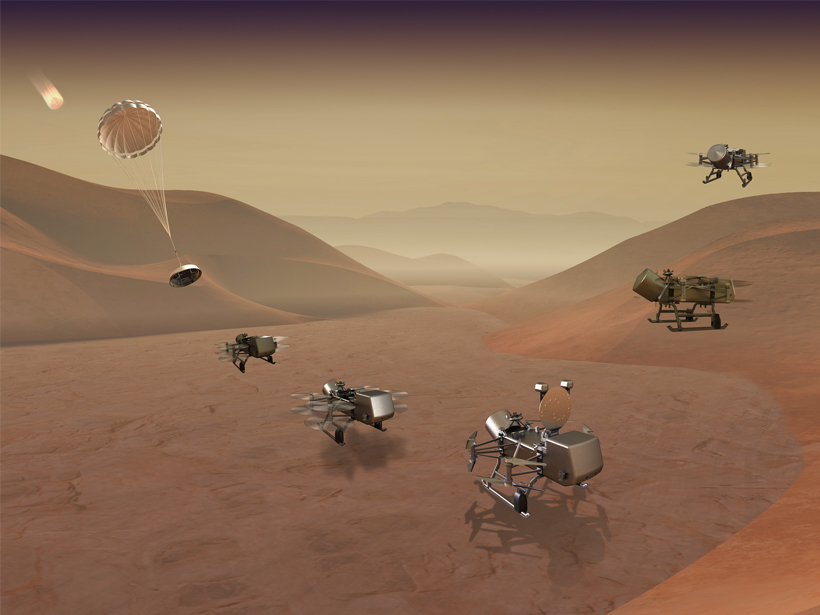If you were anywhere near science Twitter yesterday afternoon, you might have heard the news:
WE’RE GONNA SEND A DRONE HELICOPTER ROBOT TO TITAN! #Dragonfly https://t.co/TpQYtZCsu7
— Katie Mack (@AstroKatie) June 27, 2019
NASA announced its next New Frontiers mission: Dragonfly, an automated drone that will fly the skies of Saturn’s largest moon, Titan. Dragonfly, led by planetary scientist Elizabeth “Zibi” Turtle of the Johns Hopkins University Applied Physics Laboratory in Laurel, Md., will be launched in 2026 and arrive at Titan in 2034.
The nuclear-powered robotic helicopter will spend a few years flitting from one sandy spot to another, sampling Titan’s hydrocarbon dunes, exploring craters and lake beds, and sniffing out signs of life.
Planetary scientists have been itching to get back to Titan since the Huygens probe landed there in 2005. So they were understandably ecstatic at the Dragonfly reveal:
How did #AbSciCon19 feel about the #Dragonfly announcement? Sound on pic.twitter.com/aCfG1ast8w
— Laura Fattaruso (@labtalk_laura) June 27, 2019
I think I’d honestly convinced myself we wouldn’t go back to Titan in my lifetime. I can’t stop crying tears of joy. We’re going to answer the questions that keep me up at night.
— Dr./Prof. Sarah Hörst (@PlanetDr) June 27, 2019
Scientists around the world overflowed with excitement…
Took this screenshot because I just loved my Twitter feed’s excitement. pic.twitter.com/SJ1EgkM1Ip
— Dr. Jessie Christiansen (@aussiastronomer) June 27, 2019
I’m in a British pub full of space nerds and we just all went nuts when the Titan #dragonfly mission was selected. Space is great.
— Jonathan O’Callaghan (@Astro_Jonny) June 27, 2019
There’s going to be a coaxial quadcopter that can suck material into its mass spectrometer flying around in the atmosphere of the giant moon of Saturn.
…I love living in the future #Dragonfly— Michele Bannister (@astrokiwi) June 27, 2019
I’m living for Zibi’s joy! #Dragonfly pic.twitter.com/eQPYGo4gMq
— James Tuttle Keane (@jtuttlekeane) June 27, 2019
…and Titan was happy to be getting a new friend:
— Alex Parker (@Alex_Parker) June 27, 2019
Some questioned the nature of reality:
I just checked pic.twitter.com/LOd4Ajq6jr
— Dr./Prof. Sarah Hörst (@PlanetDr) June 28, 2019
But Titan is so totally fetch…
Nobody:
NASA: “Get in loser we’re going to Saturn’s moon” #dragonfly pic.twitter.com/WWAfuvOMEz— Stephanie E Suarez (@geologiststephy) June 27, 2019
…that people immediately began celebrating humanity’s return to the most Earth-like place in the solar system:
When the #Dragonfly @JHUAPL crew gets their much due recognition at #AbSciCon2019 #AbSciCon2019. Great job everyone! pic.twitter.com/DMZvdUBbUj
— L. Miché Aaron (@Astrenome) June 27, 2019
We have a cake in honor of the New Frontiers announcement. @PlanetDr
Design added post 4pm, courtesy @JessicaSpake pic.twitter.com/0YHjdJLcoi
— Sarah E Moran (@Of_FallingStars) June 27, 2019
Saturn and I have a lot to celebrate tonight #dragonfly #Titan #SPACETHO pic.twitter.com/uKiOIAbDPQ
— Erin Ross (@ErinEARoss) June 28, 2019
Dr Zibi Turtle (@Eretmochelys) gets a rockstar welcome at the @JHUAPL celebration for the #Dragonfly selection. Her joy as she thanked the lab and the team for their support and hard work is contagious! #NotCryingYouAre pic.twitter.com/8jLj3lu4d8
— Dr. Angela Stickle (@schmemela) June 28, 2019
And the happiness continued the next day:
Bought myself a happy Dragonfly day present pic.twitter.com/Bigiq7wUS9
— Dr./Prof. Sarah Hörst (@PlanetDr) June 28, 2019
So excited this morning remembering all over again that we are going back to Titan! #Dragonfly pic.twitter.com/3Z4OIxa5gL
— Ellen Stofan (@EllenStofan) June 28, 2019
The wait to get back to Titan has been long:
YAY #DRAGONFLY! I’m so excited! (Sketch from DPS/EPSC ‘17.) pic.twitter.com/o6ae3EWqqc
— James Tuttle Keane (@jtuttlekeane) June 27, 2019
This is the final paragraph of my PhD dissertation (from 2011). Just give it a little time 2011 Sarah, a mission beyond your wildest dreams is coming and they’ll let you help.pic.twitter.com/yndG4ONqRB
— Dr./Prof. Sarah Hörst (@PlanetDr) June 28, 2019
The wait for Dragonfly data will be even longer:
When you have to wait until 2034 to see some dank scientific imagery and data from another planet’s moon. #Dragonfly #AbSciCon2019 #AbSciCon19 pic.twitter.com/XmyKwZN1yv
— L. Miché Aaron (@Astrenome) June 27, 2019
But one thing’s now for certain: We’re going back to Titan!
Yes. Yes we are. pic.twitter.com/lG9k8eL9jR
— Dr./Prof. Sarah Hörst (@PlanetDr) June 27, 2019
—Kimberly M. S. Cartier (@AstroKimCartier), Staff Writer
Citation:
Cartier, K. M. S. (2019), Spirits are flying high for Dragonfly and Titan, Eos, 100, https://doi.org/10.1029/2019EO127415. Published on 28 June 2019.
Text © 2019. AGU. CC BY-NC-ND 3.0
Except where otherwise noted, images are subject to copyright. Any reuse without express permission from the copyright owner is prohibited.

